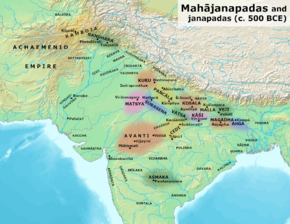History:Vajji
Vajji | |||||||
|---|---|---|---|---|---|---|---|
| c. 700 BC–c. 400 BC | |||||||
 Vajji and other Mahajanapadas in the Post Vedic period. | |||||||
| Capital | Vaishali[1] | ||||||
| Common languages | Maithili, Prakrit, Sanskrit | ||||||
| Religion | Jainism Hinduism Buddhism | ||||||
| Government | Republic[1] | ||||||
| Maharaja | |||||||
| Historical era | Bronze Age, Iron Age | ||||||
• Established | c. 700 BC | ||||||
• Conquered by Ajatashatru of Magadha | c. 400 BC | ||||||
| |||||||
| Today part of | |||||||
Vajji (Sanskrit: वृज्जी Hindi: वज्जि ) or 𝗩𝗿𝗶𝗷𝗶 was a confederacy of neighbouring clans including the Licchavis and one of the principal mahājanapadas of Ancient India. The area they ruled constitutes the region of Mithila in northern Bihar and their capital was the city of Vaishali.[1]
Both the Buddhist text Aṅguttara Nikāya and the Jaina text Bhagavati Sūtra (Saya xv Uddesa I) included Vajji in their lists of solasa (sixteen) mahājanapadas.[2] The name of this mahājanapada was derived from one of its ruling clans, the Vṛjis. The Vajji state is indicated to have been a republic. This clan is mentioned by Pāṇini, Chanakya and Xuanzang.[3] In Xuanzang's record, two clans were linked with Vajji/Mithila by 646: Vaishali and Vrijji. Vaishali was both Buddhist and Hindu while Vrijji was predominantly Hindu and the capital of it Zhanshuna (占戍挐, possibly "Cemśoṇa/Cansuna" at Baliraajgadh[4]).
The territory
The territory of Vajji was located north of the Ganges in Bihar and extended up to the Madhesh region. On the west, the Gandaki River was probably the boundary between Vajji and the Malla mahājanapada and possibly also separated it from the Kosala mahājanapada. On the east, its territory probably extended up to the forests along the banks of the rivers Koshi and Mahananda. The capital of this mahājanapada was Vaishali. Other important towns and villages were Kundapura or Kundagrama (a suburb of Vaishali), Bhoganagara and Hatthigama.[5]
Ruling clans
The rulers of Vajji were a confederacy of the eight clans (atthakula) of whom the Vajjis, the Licchavis, the Kshatrikas and the Videhas were the most important. Manudeva was a famous king of the Licchavi who desired Amrapali after he saw her dance in Vaishali.[6][|permanent dead link|dead link}}] The identities of the other four clans are not certain. However, in a passage of the Sutrakritanga, the Ugras, the Bhojas, the Kauravas and the Ikshvakus are associated with the Kshatrikas and Licchavis as the subjects of the same ruler and the members of the same assembly.[7]
Gallery
Ananda Stupa, built by the Licchavis at Vaishali, which served as the capital of Vajji, one of the world's earliest republics (Gaṇa sangha).
See also
- Kingdoms of Ancient India
- List of rulers of Mithila
References
- ↑ Jump up to: 1.0 1.1 1.2 Patrick Olivelle (13 July 2006). Between the Empires: Society in India 300 BC to 400 AD. Oxford University Press. pp. 15–. ISBN 978-0-19-977507-1. https://books.google.com/books?id=efaOR_-YsIcC&pg=PA15.
- ↑ Raychaudhuri Hemchandra (1972), Political History of Ancient India, Calcutta: University of Calcutta, pp.85-6
- ↑ Raychaudhuri Hemchandra (1972), Political History of Ancient India, Calcutta: University of Calcutta, p.107
- ↑ ISBN 9789867332677 page 485
- ↑ Raychaudhuri Hemchandra (1972), Political History of Ancient India, Calcutta: University of Calcutta, pp.105, 107
- ↑ [1]
- ↑ Raychaudhuri Hemchandra (1972), Political History of Ancient India, Calcutta: University of Calcutta, pp.105-06


